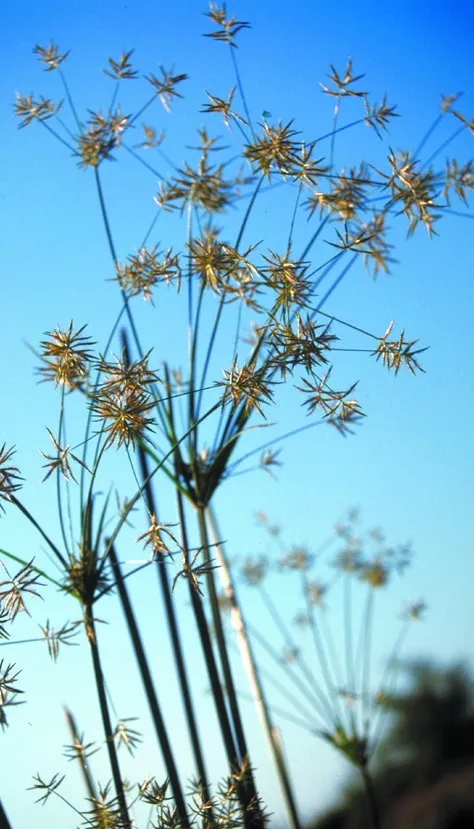Yarkon Nut-grass
Cyperus corymbosus


The root of Cyperus corymbosusis used for making emetics and for making flour.
Cyperus corymbosus formerly grew in three regions but survives today in only one: it is extinct from Wadi Sorek (Rubin) in the Philistine Plain and from the Yarkon sources in the Sharon. In the Hula Valley it was collected from En Te'o and the Hula marshes until the 1950s, and then became extinct. The only surviving populations are found in the eastern springs in the valley that flow from the Golan foothills – En Dardara (Wadi Yadbir) and En Notera (Tina). At the last site a stable population exists since 1979; in 1990, ten clumps of C. corymbosus were observed, but only three in 1998. The plants are vigorous and bloom abundantly throughout the summer. In the Flora Palaestina the species is also noted from the Kinarot Valley, but we could not find any evidence to support this. Oz Golan observed C. corymbosus in the Gaza Strip (Tel Katifa) in 2005.
Edges of rivers and streams flowing from clear-water springs.
Cyperus corymbosus is a very large genus with about 300 (some say 600) plant species, growing across all continents of the world, mainly in tropical and subtropical areas. As we move northwards in latitude, the number of Cyperus species decreases and the number of Carex (which is mostly a northern genus) species increases. Israel has 21 Cyperus species while in all of Europe there are only 27 species, which suggests a significant tropical impact on the vegetation in the country.
Most Cyperus species are aquatic herbaceous plants with thickened rhizomes. In certain species, the rhizome is used as a source of carbohydrates or of medicinal materials. The most famous Cyperus species are C. papyrus and C. rotundus, which is sometimes considered the most noxious weed in the world.
The C. corymbosus populations in Israel may belong to a special sub-species; the Cyperus expert who examined the plants from Israel found that the inflorescence rays in the corymbosus population and in the populations at En Notera are much longer than the typical size.
Morphologically it belongs to a Cyperus group with tall leafless culms, which reach height of over 1 m. It is very similar to C. articulates, but its culm is not jointed. It differs from similar species in the triangular cross-section of the upper part of the culm, and in the existence of distinct involucral bracts at the base of the inflorescence umbel. It differs from C. papyrus in its simple umbel and very long spikelets.
• Cyperus corymbosus survived in only two out of six sites. The species is extinct in the coastal plain. Its habitat is very vulnerable due to the increase of water pumping and destruction of the sections on which it grew.
• Only one site (En Notera) is included in a reserve.
The Cyperus corymbosus population at En Notera should be monitored and grazing at the site should be controlled; attempts should be made to locate additional locations in which C. corymbosus grows, particularly in the Bet Tsayda valley, in the Jordan River and in the Hula Valley.
Cyperus corymbosus is widely distributed in tropical Asia and Africa. In the Middle East, it grows only in the hot marshy areas of Southern Iraq; in Asia, it grows in India, Indo-China and in China, and its distribution reaches Japan. C. corymbosus also grows in Africa and in equatorial South America.
: Cyperus corymbosus is a beautiful tropical species, with tall culms topped by a branched inflorescence. It has been classified as a red species in danger of extinction as it survives at only two sites, both in the eastern Hula springs, and because of its high extinction rate in regions and sites on which it grew in the past, as a result of the drying up of its aquatic habitat. The Hula Valley is also the northern limit of the range of C. corymbosus.
Current Occupancy Map
| 1000 squre meter pixel | 5000 squre meter pixel | 10000 squre meter pixel | |
|---|---|---|---|
| number of observations | 0 | 0 | 0 |
| in total pixels | 0 | 0 | 0 |
| Family | Cyperaceae |
| Classification | On the endangered species list |
| Ecosystem | Mediterranean humid |
| Chorotype | Tropical |
| Conservation Site | En Notera (Tina) south of Gonen |
| Rarity |
1
5
6
|
|---|---|
| Vulnerability |
0
3
4
|
| Attractiveness |
0
1
4
|
| Endemism |
0
0
4
|
| Red number |
1
5.3
10
|
| Peripherality | S |
| IUCN category | DD EW EX LC CR EN VU NT |
| Threat Definition according to the red book | Critically endangered |
 Based on:
Based on:





